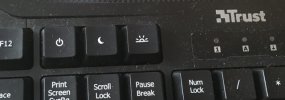Back in the day people took a knotted rope and slapped themselves on the back with it.I'm trying to unpick the chain of operations which result in output from the printer, specifically to understand colour management.
Has that got boring?


Back in the day people took a knotted rope and slapped themselves on the back with it.I'm trying to unpick the chain of operations which result in output from the printer, specifically to understand colour management.


 eu.perixx.com
eu.perixx.com

...and that's a good thing, having just hit one by mistake!it doesn't have the handy sleep and off buttons on my current Trust

...and once I was certain: I cut off the USB-C, shortened the cable (it only has to go to the KVM switch), and fitted a conventional USB plug. Still very happy with it.Adapter turned up yesterday, just in time for the last day of a big authoring job, and the Perixx 210 suits me fine (once I added a couple of rubber feet to increase the rake).
I've hit another wrinkle with my notebook-on-external-screen setup: HDMI sound. After a wake-up, the Sound dialogue I get when I right-click the "speaker" icon in the notification area and select "Playback devices" shows "HDMI Device" as default and audio activity on the level meter, but no sound comes out of the display until I make a different device the default and then make the HDMI default again... then it works fine until I put the system to sleep.Brilliant. That worked, many thanks for the clarifications. I've called itdevcon64.exe, to be explicit.
In case anybody needs a summary:
How to add command line control over stuff normally done through Device Manager in Windows
- Download the relevant .cab file from https://superuser.com/questions/1002950/quick-method-to-install-devcon-exe. I'm using 64-bit Win7, which requires the "amd64" version (apparently) rather than the "x86" version, regardless that I have an Intel processor (if using 32-bit Windows, you need the "x86" version). The "Windows 10 version 1809" revision worked for me, despite me running Win7.
- Drill into the .cab file (it's like a zip) and extract the file listed on the web page - in the case of Win10 v1809 for amd64, that's file
filbad6e2cce5ebc45a401e19c613d0a28ffrom787bee96dbd26371076b37b13c405890.cab, and rename itdevcon.exe(or whatever you like).
- I then put it into
C:\Windows\system32(requires admin access to do this), where it is on the default command search path, but you could put it anywhere if you use an explicit path when calling.
- From the Start menu, search "cmd" and right-click the search result "cmd.exe", select "Run as Administrator". This produces a command console running at Admin privilege. The command "devcon help" provides a command list, and "devcon help <command>" provides more details.
I’m no Unix/Linux expert - but I’m with you on this one. I prefer things to be where they’ve always been and to link new nomenclature to old places. But does it matter? No. So long as the links are in place and not circular - no problem.Why that way around and not put everything in /bin (as per the original Unix) is something else to get my head around.
That rings a bell from either 20.1 or 20.0 - I saw an Update Manager update this morning, but haven't looked further - so it's not entirely new. It was no hassle anyway.I've been looking at the installation/upgrade notes for Linux Mint 20.2, and they're making an issue about merging /bin and /usr/bin, etc.
Dunno. It would make sense (to me) to put things in the shorter path, as there is less to type when you have to, but otherwise it makes diddly squat difference as everything is on the PATH anyway (although /usr/bin usually comes before /bin).Why that way around and not put everything in /bin
Will that not then save a few processor cycles each time?although /usr/bin usually comes before /bin
for %%1 in <wildcard file selection> do <process_name> %%1 > %%1.outfor f in *.txt; do bash -c "cat \"$f\" >\"$f.out\""; done